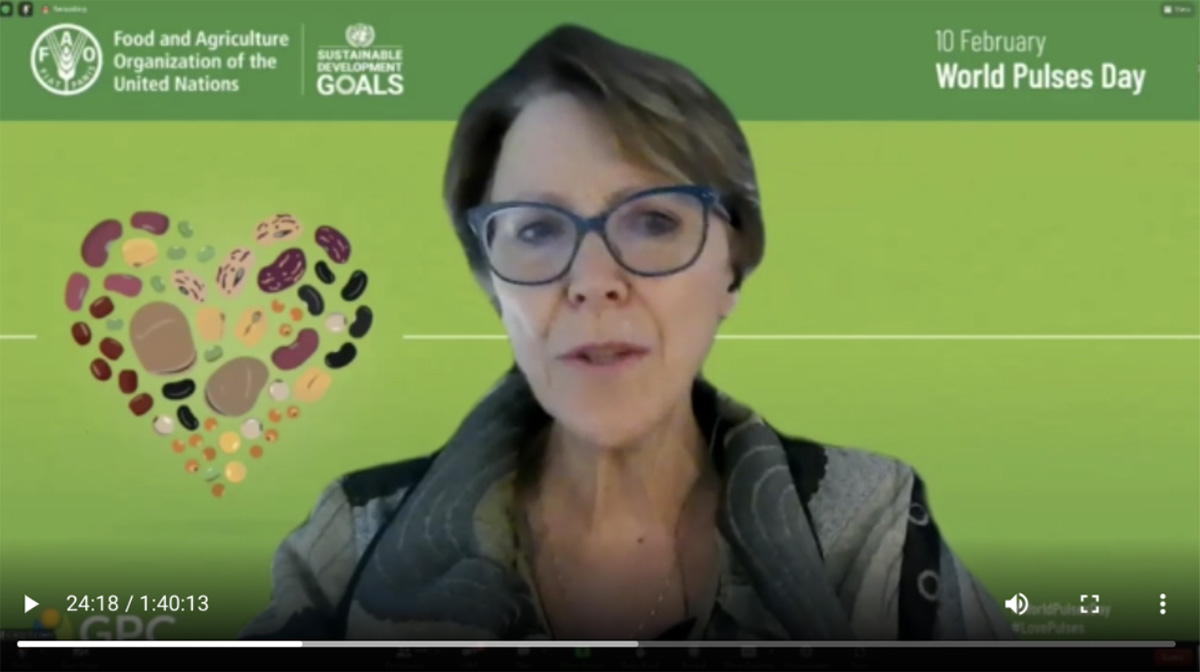February 14, 2023
Events were and continue to be held throughout the month to celebrate the 5th annual World Pulses Day. GPC hosted two in-person events in London and Gdansk while FAO hosted its annual webinar.

The United Nations Food & Agriculture Organization (FAO) marked World Pulses Day 2023 with a virtual global gathering on Friday, February 10, which featured opening remarks by the FAO Director-General, QU Dongyu. The webinar aimed to highlight how pulses increase the resilience of farming systems thanks to their low water need, high drought tolerance and ability to resist climate-related disasters.
The event also shone a spotlight on the global pulses sector, highlighting its importance in ensuring the resilience of supply chains at the regional and global levels and therefore enabling populations to access nutritious, affordable foods.
“Pulses contribute in diverse ways towards the transformation of our agrifood systems, and can help us address multiple global crises,” said Director-General, QU Dongyu, later pointing out that pulses are key in the achievment of the Sustainable Development Goals (SDGs) by 2030.

The first keynote speaker was Saadia Elmubarak Ahmed Daak, Alternate Permanent Representative of the Republic of the Sudan to FAO, who spoke about the important role pulses play in Sudanese food culture, explaining that many smallholder farmers grow them due to their low fertilizer needs and indicating that, in Sudan, research is being carried out on how to produce higher-yielding, more climate change resilient lentils and chickpeas.
The second keynote speaker was Cindy Brown, President of the Global Pulse Confederation, who focused on the vital need for increased production and consumption of pulses. She stressed that growing pulses can and will mitigate the adverse effects of climate change and food insecurity and indicated the importance of building and maintaining resilient trade systems across the world as a key factor in working towards a sustainable future.
President Brown’s speech was followed by a video explaining how pulses “can provide benefits that other plants can only dream of” and have the potential to transform agrifood systems and unlock a sustainable future for all.
The next speaker was Ibrahim Assane Mayaki, Honorary President, Sahel and West Africa Club Secretariat (SWAC) who spoke about pulses for developing sub-Saharan Africa sustainably. He highlighted that although pulses have traditionally made up part of the diet of sub-Saharan Africa, economical constraints from the COVID-19 pandemic and subsequent global conflicts and logistical issues have hindered production and consumption. He underlined the magnitude of the malnutrition issue affecting the world and explained the extent of the impact of climate change on farming systems, stressing that pulses are key in mitigating these issues. Finally, he discussed the African Union’s drive for more self-sufficiency in food and the importance of protecting local, indigenous food systems in order to improvie sustainability.
Next, there was a presentation on “The national strategy for plant protein: An example from France” by Maud Iacomelli, Deputy Head of the Unit for field crops, seeds and processed products, Ministry of Agriculture and Food Sovereignty, France. She discussed France’s three goals for the 10-year plant protein strategy: to reduce imports of animal proteins, improve food sovereignty and increase the production of plant proteins, including pulses.
This was followed by a presentation on the “Future of pulses for sustainable development in Latin America and the Caribbean” by Tito Claure, Chief Coordinator, Latin American Network of Pulse Researchers. He pointed out that populations in the Carribbean and Latin America are in the process of a shift away from “slow” food (referencing pulses’ slower cooking times) towards “fast” food (cereals, which are quicker and easier to prepare). Pulses are receiving little attention and resources and, as a result, are not produced or consumed as much as other crops. However, many smallholder farmers in the region produce pulses for their own consumption and there is much research and work being done to promote the consumption and cultivation of pulses.
The final presentation was “The hidden benefits of pulses” by Rujuta Diwekar, a leading sports science and nutrition expert from the Republic of India. She explained how, in India, all the benefits of pulses are passed on through an oral tradition, mainly from grandmothers. Not only are they a key part of diets in the country, they are also used as a way to learn life lessons and help to celebrate India’s many differences in language and cuisine; there are even special daals that are made to celebrate diversity. She also pointed out that pulses are used in a variety of ways therapeutically, even for the skin.
The webinar was rounded off with a Q&A session before the Closing Remarks by Her Excellency Fatimata Cheiffou, Ambassador and Permanent Representative of the Republic of the Niger to FAO and Chairperson of the World Pulses Day Steering Committee.
Disclaimer: The opinions or views expressed in this publication are those of the authors or quoted persons. They do not purport to reflect the opinions or views of the Global Pulse Confederation or its members.